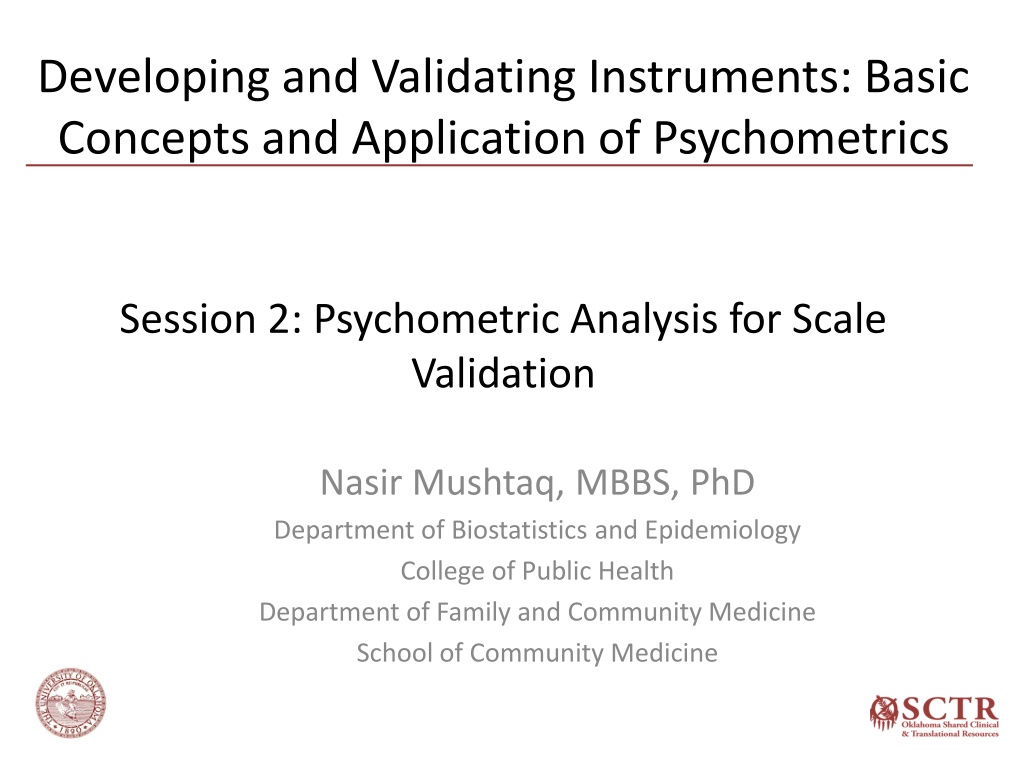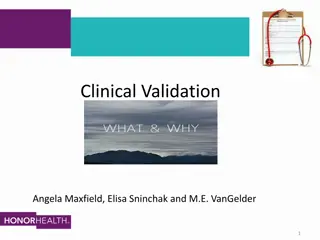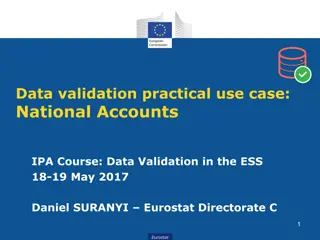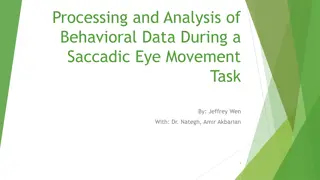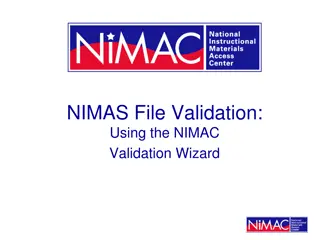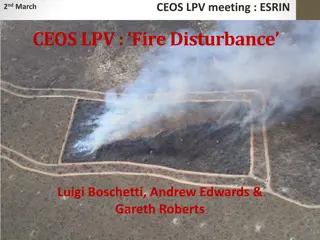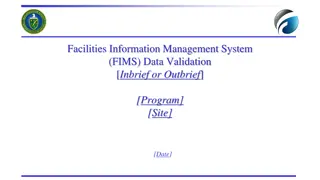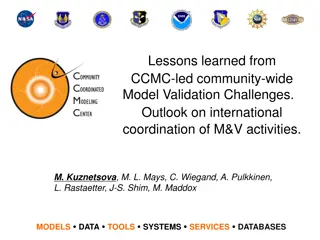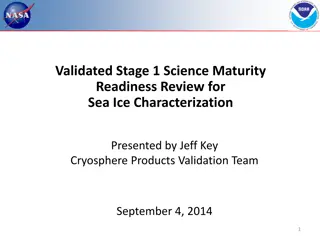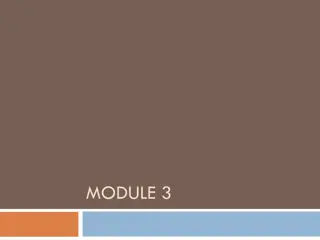Understanding Psychometric Analysis for Scale Validation
Explore the key concepts of psychometric analysis to validate measurement instruments. Delve into reliability assessments like split-half reliability and Cronbach's alpha for internal consistency. Gain insights into statistical methods for evaluating psychometric properties of scales.
Download Presentation

Please find below an Image/Link to download the presentation.
The content on the website is provided AS IS for your information and personal use only. It may not be sold, licensed, or shared on other websites without obtaining consent from the author. Download presentation by click this link. If you encounter any issues during the download, it is possible that the publisher has removed the file from their server.
E N D
Presentation Transcript
Developing and Validating Instruments: Basic Concepts and Application of Psychometrics Session 2: Psychometric Analysis for Scale Validation Nasir Mushtaq, MBBS, PhD Department of Biostatistics and Epidemiology College of Public Health Department of Family and Community Medicine School of Community Medicine
Learning Objectives Describe psychometric properties and essential components of scale validation Discuss different statistical methods and procedures to evaluate pertinent psychometric properties of scales Understand and explain the program syntax and resulting output from statistical packages used for psychometric analysis
Psychometric Analysis Analysis of scales (measurement instruments) to ensure these are Reliable Valid Objective Improve a scale Validate
Reliability Indicator of consistency Reliability of scales indicates the degree to which they are accurate, consistent, and replicable Basic CTT Observed (X) = True (T) + Error (E) Across people ????????? 2 2 2 = ????? + ?????? 2 2 2 ????? = ????????? ?????? Reliability Coefficient 2 ????? ????????? ???= 2 2 2 ????????? ?????? ???= 2 ?????????
Reliability Split-Half Reliability Reliability (???) is assessed by the Spearman-Brown Prophecy formula ???= 2??? 1+??? Correlation (??? )between the scores of two halves Parallel-Forms (Alternate-Forms) Reliability Test-Retest Reliability (Temporal Stability) Coefficient of stability Correlation between the observed scores of the same test administered at two separate occasions
Reliability Methods to measure internal consistency reliability for scale validation Cronbach s alpha Item-total correlation Inter-item correlation
Reliability Cronbach s Alpha (Coefficient Alpha) Most commonly used measure of internal consistency reliability Calculation slightly complex Assumptions Errors are not correlated with one another Other assumptions of essentially tau-equivalent model Alpha is the proportion of a scale s total variance that is attributable to a common source
Reliability Cronbach s Alpha (Coefficient Alpha) 2 ? 11 ?? ? ? = 2 ?? ? = Coefficient alpha ? = number of items ??2 = Total variance of the scale ?? 2 = variance of the item Alpha ranges 0 to 1 larger value indicates higher level of internal consistency
Example Cross Sectional Study Design Data Community based sample, n=95 Self administered mail survey of adult current exclusive ST users ST Dependence Measures Fagerstr m Test of Nicotine Dependence (FTND-ST) Six items scale Total scale ranges from 0 to 10 Salivary cotinine concentration Tobacco Dependence Screener (TDS) Oklahoma Scale for Smokeless Tobacco Dependence (OSSTD)
Example Table 1. Response to FTND-ST items FTND items with response (scores) n (%) 1. How soon after you wake up to do you place your first dip? Within 5 minutes (3) 6 30 minutes (2) 31 60 minutes (1) After 60 minutes (0) 2. How often do you intentionally swallow tobacco juice? Always (2) Sometimes (1) Never (0) 3. Which chew would you hate to give up most? The first one in the morning (1) Any other (0) 4. How many cans/pouches per week do you use? More than 3 (2) 2 3 (1) 1 (0) 5. Do you chew more frequently during the first hours after awakening than during the rest of the day? Yes (1) No (0) 6. Do you chew if you are so ill that you are in bed most of the day? Yes (1) No (0) 8 (8.42) 32 (33.68) 17 (17.89) 38 (40.00) 10 (10.53) 34 (35.79) 51 (53.68) 41 (43.16) 54 (56.84) 37 (38.95) 43 (45.26) 15 (15.79) 14 (14.74) 81 (85.26) 34 (35.79) 61 (64.21)
Reliability Cronbach s Alpha (Coefficient Alpha) SAS Syntax ProcCorr Data=FTND NoCorr ALPHA NOMISS; Var FTND_1 FTND_2 FTND_3 FTND_4 FTND_5 FTND_6; Run; Alpha: Cronbach s Alpha NoCorr NoMiss
Reliability Cronbach s Alpha (Coefficient Alpha) SAS Output Raw based on covariance matrix Standardized based on the correlation matrix
Reliability Cronbach s Alpha (Coefficient Alpha) SAS Output
Reliability Item-total correlation Zero-order correlation between total score and items Inter-item correlation Zero-order correlation between items SAS Syntax ProcCorr Data=FTND PEARSON SPEARMAN NOMISS; Var FTNDTotal FTND_1 FTND_2 FTND_3 FTND_4 FTND_5 FTND_6; Run; Pearson: Pearson product moment correlation Spearman: Spearman rank-order correlation
Reliability Item-total correlation SAS Output
Reliability Inter-item correlation SAS Output
Reliability Internal consistency criteria Measure Criteria Cronbach s Alpha > 0.70* Item-total correlation > 0.20 Inter-item correlation 0.15 0.85 * > 0.95 indicates redundancy
Reliability Threats to Reliability Homogeneity of the sample Number of items (Length of the scale) Quality of the items and complex response options
Validity Extent to which a scale is truly measuring what it is intended to measure. Does the scale measure the construct under consideration Types of Validity Face Validity Content Validity Criterion validity Concurrent Validity Predictive Validity Construct Validity Qualitative Methods Quantitative Methods
Face Validity Superficial assessment of the scale If the scale looks like to measure what it claims to measure Example: Physical dependence on smokeless tobacco (Tolerance) I am around smokeless tobacco users much of the time How many cans/pouches of smokeless tobacco per week do you use? Face validity of the following in measuring tobacco dependence: I enjoy the sensations of a long, slow exhalation of smoke.
Content Validity Extent to which a scale measures its intended content domain Domain Sampling Theory An infinite number of items assess a construct Scale is a sample of these items Content validity assesses sampling adequacy Representativeness of the scale for the intended construct Qualitative evaluation of the scale
Validity Criterion Validity
Criterion Validity Extent to which a scale is related to another scale/ criterion or predictor Concurrent Validity Association of the scale under study with an existing scale or criterion measured at the same time Predictive Validity Ability of a scale to predict an event, attitude, or outcome measured in the future
Concurrent Validity Criterion variable (Gold standard) Previously validated measure Scales measuring the same broader construct Same or other dimensions the construct Other characteristics Factors related to the same domain Assessed at the same time (concurrently) when the scale under study was administered
Concurrent Validity Example Evaluation of FTND-ST Criterion Variable Salivary cotinine concentration Other ST dependence scales Tobacco Dependence Screener (TDS) based on DSM-IV & ICD-10 Oklahoma Scale for Smokeless Tobacco Dependence (OSSTD) Severson Smokeless Tobacco Dependence Scale (SSTDS) ST use characteristics Quantity of ST use (number of cans per week CPW) Frequency of ST use (number of dips per day DPD) Duration of ST use (years of ST use)
Concurrent Validity Example Evaluation of FTND-ST Statistical Test Correlation analysis SAS Syntax ProcCorr Data=FTND; Var FTNDTotal SCotinine TDSTotal OSSTD SSTDS CPW DPD STUseYr; Run;
Concurrent Validity Example Evaluation of FTND-ST Results Table 2. Zero order correlation between FTND-ST and other dependence measures (Concurrent validity) Dependence Measure r (p-value) Cotinine 0.620 ( <0.0001) TDS 0.436 ( <0.0001) OSSTD 0.526 ( <0.0001) CPW 0.620 ( <0.0001) DPD 0.478 ( <0.0001) Years of ST use 0.508 ( <0.0001)
Concurrent Validity Example Evaluation of FTND-ST Statistical Test Simple Linear Regression ProcReg Data=FTND; Model SCotinine = FTNDTotal; Run; OR %Macro TUC (var1=); Proc Reg Data=FTND; Model FTNDTotal = &var1; Run; %Mend; %TUC (var1=TDSTotal); %TUC (var1=SCotinine); %TUC (var1=CPW); %TUC (var1=DPD); %TUC (var1=STUseYr); End;
Concurrent Validity Example Evaluation of FTND-ST Table 3. Association of FTND-ST with other dependence measures and tobacco use characteristics Results of simple linear regression analysis Dependence Measures / ST Use Characteristics Parameter Estimate Standard Error r2 t-test p-value Cotinine 0.170 0.022 7.62 <0.0001 0.385 TDS 0.423 0.091 4.67 <0.0001 0.190 CPW 0.706 0.093 7.61 <0.0001 0.384 DPD 0.269 0.051 5.25 <0.0001 0.229 Years of ST use 0.116 0.020 5.68 <0.0001 0.258
Concurrent Validity Example Evaluation of FTND-ST items Correlation analysis Table 4. Association between cotinine and FTND-ST items FTND-ST item r (p-value) Item 1 Item 2 Item 3 Item 4 Item 5 Item 6 0.663 (<0.0001) 0.418 (<0.0001) 0.385 (0.0001) 0.324 (0.0013) 0.123 (0.236) 0.285 (0.005) Cotinine 0.373 (0.0002) 0.224 (0.0294) 0.276 (0.0068) 0.143 (0.1679) 0.310 (0.0022) 0.454 (<0.0001) TDS
Concurrent Validity Example Evaluation of FTND-ST items Multiple regression analysis SAS Syntax ProcReg Data=FTND; Model SCot = FTND_1 - FTND_6; Run;
Concurrent Validity Example Evaluation of FTND-ST items Multiple regression analysis
Predictive Validity Ability of a scale to predict an event, attitude, or outcome measured in the future Example Predictive validity of FTND-ST for assessing ST cessation. Predictive validity of Braden scale for assessing the risk of pressure ulcers. Statistical tests Correlation analysis Regression analysis
Validity Construct Validity
Construct Validity Relies on the theoretical framework used to define the construct Convergent Validity and Discriminant Validity Extent to which a scale is related to other variables or scales within the system of theoretical relationships. Convergent Validity Discriminant Validity Test A Test B Test C Test D Theoretical +++ ++ 0 0 Observed +++ ++ 0 0 Structure model (Factor analysis) Scale dimensionality
Factor Analysis Identify latent factors underlying a set of observable variables Types Exploratory Factor Analysis (EFA) Data-driven approach to discover/explore unknown factorial structures Confirmatory Factor Analysis (CFA) Theory-driven approach to confirm hypothesized factorial structures
Exploratory Factor Analysis Performed in the absence of sufficient theoretical or empirical information about the structure model of the scale. Appropriate number of underlying factors are determined. Unidimensional vs. multidimensional Methods to extract factors: Principal factor, maximum likelihood, unweighted least squares, etc. Rotation of factors Orthogonal rotations (Varimax): Forces the resulting factors to be uncorrelated. Oblique rotations (Promax): Allows correlations between the factors
Exploratory Factor Analysis Criteria for extracting factors: Kaiser eigenvalue criteria Factors with eigenvalues > 1 Scree test Examine scree plot. Magnitude of eigenvalues on Y-axis and number of factors on X-axis. Retain factors above the elbow. Proportion of variance accounted for Retain a factor if it accounts for more than a specified proportion of variance in the dataset.
Exploratory Factor Analysis Criteria for extracting factors Interpretability criteria Factors with > 3 with significant factor loadings. Variables that load on a factor share some conceptual meaning. Variables that load on different factors measure different construct/dimension. Rotated factor pattern demonstrate simple structure High loadings on one factor Low loadings on other factors Parallel test Velicer s MAP test
Exploratory Factor Analysis SAS Syntax ProcFactor Data=EFA Simple Method=Prin Priors=SMC Scree Rotate=Varimax Round Flag=0.4 Mineigen=1 Nfact=2; Var ______________; Run;
Exploratory Factor Analysis Example OSSTD Primary Dependence Motives (PDM) Subscale Item No. Items Response 1 Chew/dip controls me. 1 2 3 4 5 6 7 2 I'm really hooked on chew/dip. 1 2 3 4 5 6 7 3 It's hard to ignore an urge to chew/dip 1 2 3 4 5 6 7 4 I frequently crave chew/dip. 1 2 3 4 5 6 7 5 Other chewers/ dippers would consider me a heavy chewer/dipper. 1 2 3 4 5 6 7 6 I chew/dip within the first 30 minutes of awakening in the morning. 1 2 3 4 5 6 7 7 I find myself reaching for chew/dip without thinking about it. 1 2 3 4 5 6 7 8 Sometimes I am not aware that I am chewing/dipping. 1 2 3 4 5 6 7
Exploratory Factor Analysis Example Orthogonal Rotation SAS Syntax ODS Graphics ON; ProcFactor Data=OSCTR_EFA Simple Method=Prin Priors=SMC Plot=Scree Rotate=Varimax Round Flag=0.4; Var OSSTD1 OSSTD2 OSSTD3 OSSTD4 OSSTD5 OSSTD6 OSSTD7 OSSTD8; Run; ODS Graphics OFF;
Exploratory Factor Analysis SAS Output
Exploratory Factor Analysis SAS Output
Exploratory Factor Analysis SAS Output
Exploratory Factor Analysis SAS Output
Exploratory Factor Analysis SAS Output
Exploratory Factor Analysis Example Oblique Rotation SAS Syntax ProcFactor Data=OSCTR_EFA Simple Method=Prin Priors=SMC Plot=Scree Rotate=Promax Round Flag=0.4; Var OSSTD1 OSSTD2 OSSTD3 OSSTD4 OSSTD5 OSSTD6 OSSTD7 OSSTD8; Run;
